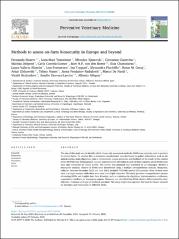| dc.contributor.author | Duarte, Fernando | |
| dc.contributor.author | Tamminen, Lena-Mari | |
| dc.contributor.author | Kjosevski, Miroslav | |
| dc.contributor.author | Ciaravino, Giovanna | |
| dc.contributor.author | Delpont, Mattias | |
| dc.contributor.author | Correia-Gomes, Carla | |
| dc.contributor.author | van den Borne, Bart H.P. | |
| dc.contributor.author | Chantziaras, Ilias | |
| dc.contributor.author | Alarcon, Laura Valeria | |
| dc.contributor.author | Svennesen, Line | |
| dc.contributor.author | Toppari, Ina | |
| dc.contributor.author | Piccirillo, Alessandra | |
| dc.contributor.author | Gecaj, Rreze M. | |
| dc.contributor.author | Zbikowski, Artur | |
| dc.contributor.author | Nunes, Telmo | |
| dc.contributor.author | Prodanov-Radulović, Jasna | |
| dc.contributor.author | De Nardi, Marco | |
| dc.contributor.author | Nedosekov, Vitalii | |
| dc.contributor.author | Desvars-Larrive, Amelie | |
| dc.contributor.author | Allepuz, Alberto | |
| dc.date.accessioned | 2025-03-13T11:46:32Z | |
| dc.date.available | 2025-03-13T11:46:32Z | |
| dc.date.issued | 2025 | |
| dc.identifier.issn | 0167-5877 | |
| dc.identifier.uri | https://repo.niv.ns.ac.rs/xmlui/handle/123456789/955 | |
| dc.description.abstract | The aim of this study was to identify which biosecurity assessment methods (BAMs) are currently used in practice
in animal farms. To address this, a structured questionnaire was developed to gather information such as the
animal species, main objectives, type of enforcement, output generated and feedback of the result. In the context
of the BETTER Cost Action project, country representatives identified in each of their countries which BAMs were
used and completed an online survey. The survey was prepared and translated in 23 languages. Besides a
descriptive analysis, clusters of BAMs were determined using a multiple correspondence analysis. Responses,
collected between December 2022 and July 2023, included 74 BAMs used in 28 countries. Most of them were
used in a single country while three were used in multiple countries. This study provides a comprehensive picture
of existing BAMs and insights into their diversity, such as variations in objectives, implementation, evaluators,
respondents, feedback, or assessment outputs. Moreover, we identified four BAMs clusters differentiated by their
objective, evaluator and type of feedback provided. This study might also represent the basis for future research
on strengths and weaknesses of different BAMs. | en_US |
| dc.description.sponsorship | Special thanks to all national focal points for their support in data
collection and validation. Thanks to all BETTER Cost Action members
for their invaluable comments, which contributed to improving the
quality of the study. This article is based upon work from COST Action
BETTER (CA20103) https://better-biosecurity.eu/, supported by COST
(European Cooperation in Science and Technology). The first author is
funded by the Chilean National Agency for Research and Development
(ANID) / Scholarship Program / DOCTORADO BECAS CHILE/
2020–72210236. | en_US |
| dc.language.iso | en | en_US |
| dc.source | Preventive Veterinary Medicine | en_US |
| dc.subject | Biosecurity | en_US |
| dc.subject | Assessment | en_US |
| dc.subject | Prevention | en_US |
| dc.subject | Farm | en_US |
| dc.subject | Survey | en_US |
| dc.title | Methods to assess on-farm biosecurity in Europe and beyond | en_US |
| dc.type | Article | en_US |
| dc.identifier.doi | 10.1016/j.prevetmed.2025.106486 | |
| dc.citation.volume | 239 | en_US |
| dc.citation.spage | 106486 | en_US |
| dc.citation.rank | M21 | en_US |
| dc.type.version | published | en_US |

